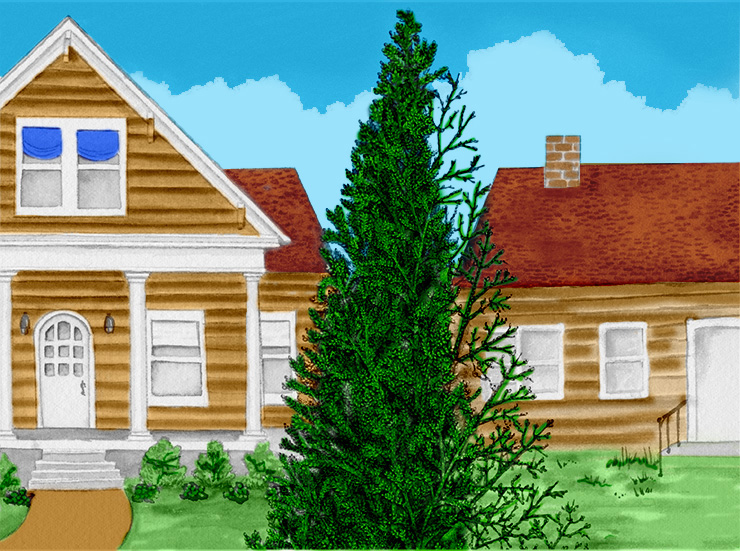Read by Matilda Longbottom
I like to read mysteries. Not the brutal kind but more of the cat-helps-find-the-missing-lunchbox type of story. It’s interesting to see how things get solved. It usually seems obvious at the end, in a satisfying “Of course!” kind of way.
I never expected to come across a mystery in real life. Yet there was something going on not far from my house that had me completely bewildered.
There are two neighboring houses around the corner from my home. Between the houses is a juniper hedge. I watched the junipers grow until they were several feet high, which is normal for those plants. What was not normal was how they grew. On one side of the hedge, the juniper was full and green. But the other side was woody and mostly bare.
I was captivated by that hedge. Here was a homegrown mystery. So I looked for clues that might explain the difference.
The grass on the green side was well tended and edged. The lawn on the bare side was unmown, beaten down, and so scraggly even the weeds were struggling to survive.
The owners of the house on the growing side tended to their property. Their house was clean, the paint pristine. There were flowers along the walkway to the front door. They would obviously care for a juniper hedge. Except how was it possible to fertilize half a bush? To water and nurture just one side of a plant?
The owners on the other side ignored their property. Not only was the lawn in sorry shape, but the house also showed signs of neglect, with one of the gutters hanging down, mildew on the siding, and seedlings sprouting on the roof. Certainly these homeowners would ignore the basic needs of a hedge—they didn’t care for the rest of their environment. But how can a plant that is not watered or fertilized wither on one side and flourish on the other?

I wondered which neighbor had planted the line of junipers—and why. It wasn’t hard to imagine that it was a deliberate attempt to separate the properties. After all, I had heard rumors of rowdy teens living in the corner house. But so what? Even if the rumor was correct, even if the “rowdy teens” were more than rowdy but were actually destructive, how could they cause damage on only one side of the hedge?
Years went by and I got used to seeing the half-green, half-brown hedge. Then one summer I noticed that the lawn on the brown side, normally a foot high, had been mowed! There were other changes. Someone had put out a patio table and chairs near the hedge, and a young couple occasionally sat there. I hadn’t seen a For Sale sign go up, but clearly the ownership had changed. There were different faces and lots of activity.
What was more, the brown half of the juniper was slowly putting out buds and turning green!
The new residents had dead trees removed and repaired the cracked sections of their sidewalk. They had topsoil delivered. Lawn sculptures appeared at different seasons. And the stark, woody hedge was being gently trimmed on their side.
That made me wonder (finally) about junipers and pruning. I checked out the proper way to prune a juniper hedge and discovered that it was important not to trim too close to the center, the “dead zone” as it was called. If the bush were ever cut to bare wood, the chances of it recovering would be slim.
Could that have been the problem, one neighbor cutting too aggressively? But if so, then why was the bare section now coming back to life?
Perhaps the power of nurturing is more important than we realize. I remembered a Christmas cactus I once had on my kitchen windowsill—one that bloomed like crazy. I went online to learn about its care. It seemed that I had to carefully monitor its light, parsimoniously give it water, and keep it in a controlled temperature of 50° to get it to flower. I was doing everything wrong! My kitchen was a) filled with light, b) probably the warmest place in the house, and c) an easy place for me to get water so the plant was frequently given a drink. According to what I was reading, this plant should not have been flourishing. Yet it was—beautifully. The only thing I could think of was that I talked to my plant, praised it a lot, and kissed it on occasion (yes, I really did). Was it responding to my loving energy, thriving the way children do in an atmosphere of acceptance and appreciation?
The new neighbors are being, well, neighborly. I chat with them as I pass on my daily walks. The house, though it still needs work, has lost its run-down look.
And the hedge is now fully green.
Maybe this wasn’t such a mystery after all, but a plant’s call for help that was, at last, answered. ❖


 Previous
Previous

